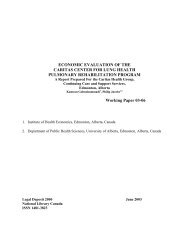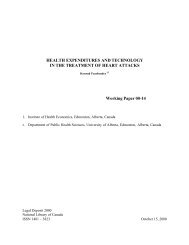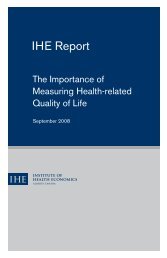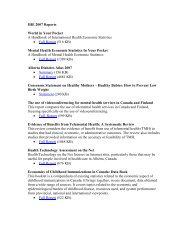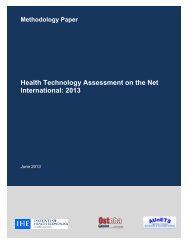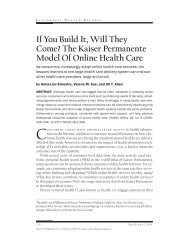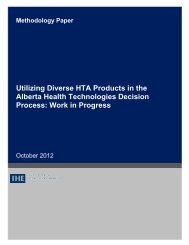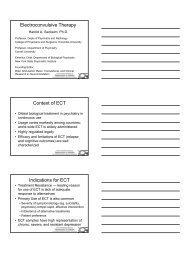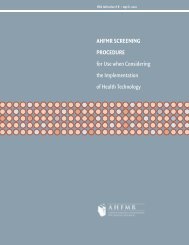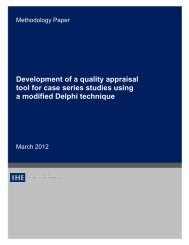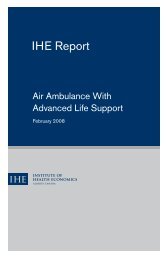Bariatric treatments for adult obesity - Institute of Health Economics
Bariatric treatments for adult obesity - Institute of Health Economics
Bariatric treatments for adult obesity - Institute of Health Economics
- No tags were found...
Create successful ePaper yourself
Turn your PDF publications into a flip-book with our unique Google optimized e-Paper software.
The authors identified many methodological limitations in the primary studies that related to eitherstudy design or statistical issues. These, in turn, had an impact on their findings and on theconclusions drawn in their review.Summary <strong>of</strong> the SOS studyThe SOS study, a large prospective multicentre cohort study with matched concurrent controls,investigates the long-term effects <strong>of</strong> bariatric surgery on comorbidities and mortality rates. Theoverall aim <strong>of</strong> the SOS study was to address the apparent discrepancy between the effects <strong>of</strong> weightloss on risk factors and the hard end points reported in previous studies. 68The Cochrane review on bariatric surgery 62 presented findings extracted from more than 20publications <strong>of</strong> the SOS study published between 1997 and 2008. These findings, supplemented byin<strong>for</strong>mation from two other recent publications, 69,70 are presented in Appendix G (see Table T.G.1-4)and summarized below.Study participants and interventionsFour thousand <strong>for</strong>ty-seven patients, aged 37 to 60 years, and having a BMI ≥ 34 kg/m 2 <strong>for</strong> men and≥ 38 kg/m 2 <strong>for</strong> women (a cut-<strong>of</strong>f that was chosen be<strong>for</strong>e the consensus on BMI cut-<strong>of</strong>f in 1991),were recruited between September 1987 and January 2001. Patients were allocated to either thebariatric surgery group (n = 2010) or a contemporaneously matched, conventionally treated obesecontrol group (n = 2037). Surgical procedures included VBG, adjustable or non-adjustable gastricbanding, or gastric bypass. Conventional treatment was not standardized, and ranged fromsophisticated lifestyle intervention and behavioural modification to no treatment.The SOS study is not an RCT. Patients were matched according to sequential treatment assignment.The following 18 variables were matched between the groups: gender, age, weight, height, waist andhip circumferences, systolic blood pressure, serum cholesterol and triglyceride levels, smoking status,diabetes, menopausal status, four psychosocial variables with documented association with the risk<strong>of</strong> death, and two personality traits related to treatment preferences. The investigators had noinfluences on the computerized matching process.The SOS study involved an interval <strong>of</strong> about nine months between matching <strong>of</strong> controls and thestart <strong>of</strong> surgical treatment that led to significant differences in weight and other possible risk factors.Compared to controls, patients in the surgical group were younger, had a higher prevalence <strong>of</strong>hypertension, higher BMI, blood pressure, and energy intake at the time <strong>of</strong> surgery.Mean baseline energy intake was higher among the surgically treated patients (2882 kcal/day) thanamong the controls (2526 kcal/day). The baseline adjusted energy intake was significantly lower inthe surgery group than in the control group over the 10-year period. Similarly, the fraction <strong>of</strong>patients who were physically active during their leisure time was higher in the surgery group over the10-year period, and the fraction <strong>of</strong> those who were physically active during work time was higher inthe surgery group <strong>for</strong> the first six years after the intervention.On 1 November 2005, the vital status was known <strong>for</strong> all but three <strong>of</strong> the initial study participants;the follow-up rate with respect to vital status on the date <strong>of</strong> analysis was 99.9%. At 2-, 10-, and 15-year follow-up, participation rates in the surgery group were 94%, 84%, and 66%, respectively, andthe corresponding participation rates in the control group were 83%, 75%, and 87%, respectively.As <strong>of</strong> February 2008 the follow-up ranged from 6 to 20 years.<strong>Bariatric</strong> <strong>treatments</strong> <strong>for</strong> <strong>adult</strong> <strong>obesity</strong> 90



